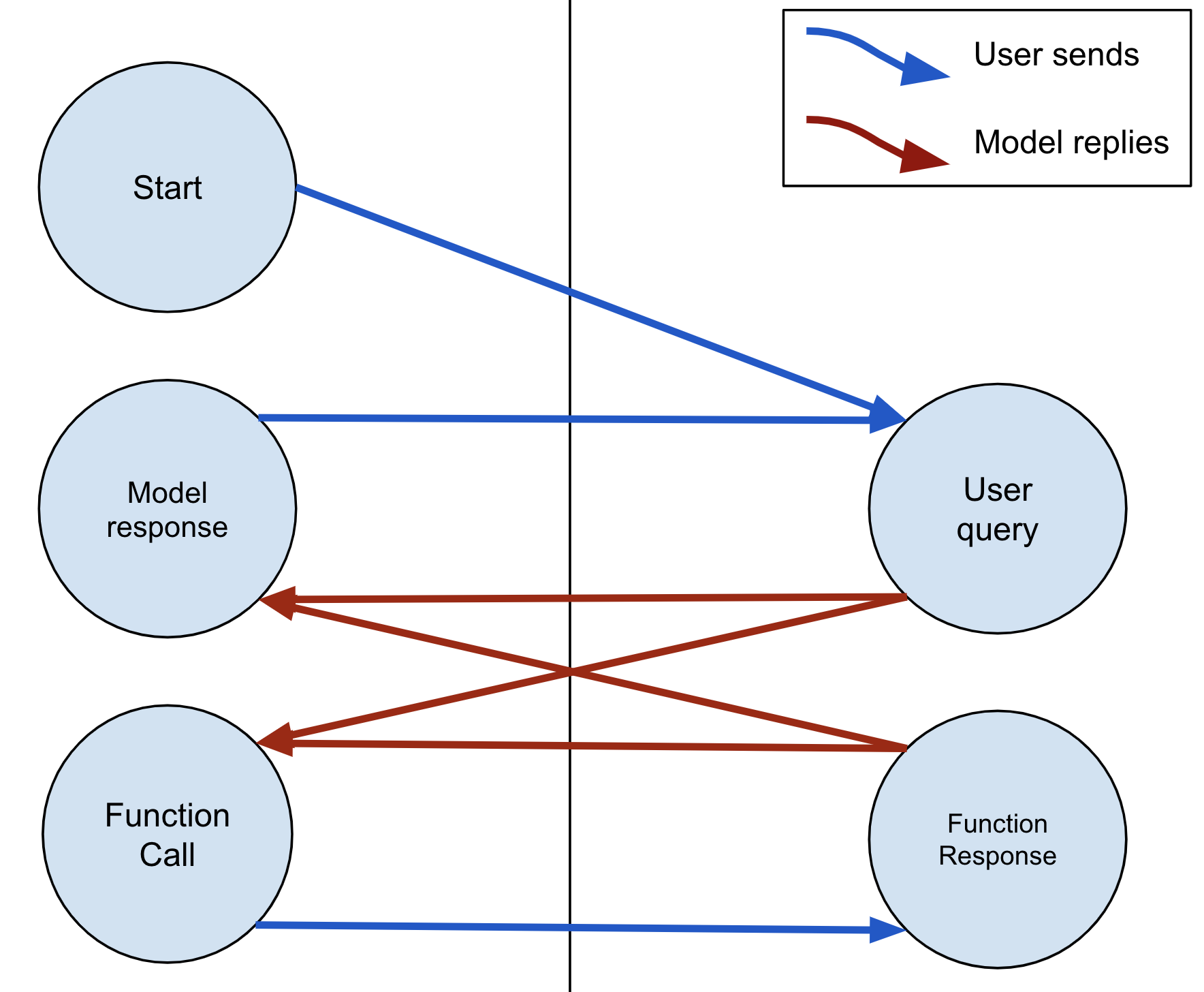|
|
 เรียกใช้ใน Google Colab เรียกใช้ใน Google Colab
|
 ดูซอร์สบน GitHub ดูซอร์สบน GitHub
|
คุณระบุโมเดล Gemini พร้อมคำอธิบายฟังก์ชันได้ โมเดลอาจขอให้คุณเรียกฟังก์ชันและส่งผลลัพธ์กลับมาเพื่อช่วยให้โมเดลจัดการการค้นหาของคุณ
ตั้งค่า
ติดตั้ง Python SDK
Python SDK สำหรับ Gemini API อยู่ในแพ็กเกจ google-generativeai ติดตั้งทรัพยากร Dependency โดยใช้ PIP:
pip install -U -q google-generativeai
นำเข้าแพ็กเกจ
นำเข้าแพ็กเกจที่จำเป็น
import pathlib
import textwrap
import time
import google.generativeai as genai
from IPython import display
from IPython.display import Markdown
def to_markdown(text):
text = text.replace('•', ' *')
return Markdown(textwrap.indent(text, '> ', predicate=lambda _: True))
ตั้งค่าคีย์ API
คุณต้องขอรับคีย์ API ก่อน จึงจะใช้ Gemini API ได้ หากยังไม่มี ให้สร้างคีย์ด้วยคลิกเดียวใน Google AI Studio
ใน Colab ให้เพิ่มคีย์ลงในตัวจัดการข้อมูลลับใต้ "🔑" ในแผงด้านซ้าย ตั้งชื่อว่า API_KEY
เมื่อมีคีย์ API แล้ว ให้ส่งคีย์ดังกล่าวไปยัง SDK โดยสามารถทำได้สองวิธี:
- ใส่คีย์ในตัวแปรสภาพแวดล้อม
GOOGLE_API_KEY(SDK จะดึงคีย์จากที่นั่นโดยอัตโนมัติ) - ส่งกุญแจไปยัง
genai.configure(api_key=...)
try:
# Used to securely store your API key
from google.colab import userdata
# Or use `os.getenv('API_KEY')` to fetch an environment variable.
GOOGLE_API_KEY=userdata.get('GOOGLE_API_KEY')
except ImportError:
import os
GOOGLE_API_KEY = os.environ['GOOGLE_API_KEY']
genai.configure(api_key=GOOGLE_API_KEY)
ข้อมูลเบื้องต้นเกี่ยวกับฟังก์ชัน
คุณสามารถส่งรายการฟังก์ชันไปยังอาร์กิวเมนต์ tools เมื่อสร้าง genai.GenerativeModel
def multiply(a:float, b:float):
"""returns a * b."""
return a*b
model = genai.GenerativeModel(model_name='gemini-1.0-pro',
tools=[multiply])
model
genai.GenerativeModel(
model_name='models/gemini-1.0-pro',
generation_config={},
safety_settings={},
tools=<google.generativeai.types.content_types.FunctionLibrary object at 0x10e73fe90>,
)
ขอแนะนำให้ใช้การเรียกใช้ฟังก์ชันผ่านอินเทอร์เฟซการแชท เหตุผลหลักก็คือ FunctionCalls เหมาะสมกับโครงสร้างแบบหมุนหลายทางของแชทพอดี
chat = model.start_chat(enable_automatic_function_calling=True)
เมื่อเปิดใช้การเรียกใช้ฟังก์ชันอัตโนมัติ chat.send_message จะเรียกใช้ฟังก์ชันของคุณโดยอัตโนมัติหากโมเดลขอให้ดำเนินการ
ดูเหมือนว่าจะส่งข้อความตอบกลับที่มีคำตอบที่ถูกต้อง:
response = chat.send_message('I have 57 cats, each owns 44 mittens, how many mittens is that in total?')
response.text
'The total number of mittens is 2508.'
57*44
2508
หากดูใน ChatSession.history คุณจะเห็นลําดับเหตุการณ์ดังนี้
- คุณส่งคำถามแล้ว
- โมเดลตอบกลับด้วย
glm.FunctionCall genai.ChatSessionได้เรียกใช้ฟังก์ชันในเครื่องและส่งโมเดลglm.FunctionResponseกลับคืนมา- โมเดลนี้ใช้เอาต์พุตของฟังก์ชันในคำตอบ
for content in chat.history:
part = content.parts[0]
print(content.role, "->", type(part).to_dict(part))
print('-'*80)
user -> {'text': 'I have 57 cats, each owns 44 mittens, how many mittens is that in total?'}
--------------------------------------------------------------------------------
model -> {'function_call': {'name': 'multiply', 'args': {'a': 57.0, 'b': 44.0} } }
--------------------------------------------------------------------------------
user -> {'function_response': {'name': 'multiply', 'response': {'result': 2508.0} } }
--------------------------------------------------------------------------------
model -> {'text': 'The total number of mittens is 2508.'}
--------------------------------------------------------------------------------
โดยทั่วไปแผนภาพสถานะจะเป็นดังนี้

โมเดลจะตอบสนองด้วยการเรียกฟังก์ชันหลายรายการก่อนส่งคืนข้อความตอบกลับ และการเรียกใช้ฟังก์ชันจะมาก่อนข้อความตอบกลับ
แม้ว่าทั้งหมดนี้จะได้รับการจัดการโดยอัตโนมัติ แต่หากต้องการการควบคุมที่มากขึ้น คุณก็สามารถทำดังนี้
- ปล่อยค่าเริ่มต้น
enable_automatic_function_calling=Falseไว้และประมวลผลคำตอบglm.FunctionCallด้วยตนเอง - หรือใช้
GenerativeModel.generate_contentซึ่งคุณต้องจัดการประวัติการแชทด้วย
[ไม่บังคับ] สิทธิ์เข้าถึงระดับต่ำ
การดึงสคีมาอัตโนมัติจากฟังก์ชัน Python ใช้งานไม่ได้ในทุกกรณี เช่น โปรโตคอลนี้ไม่รองรับกรณีที่คุณอธิบายช่องของออบเจ็กต์พจนานุกรมที่ซ้อนกัน แต่ API รองรับการดำเนินการนี้ API อธิบายประเภทต่อไปนี้ได้
AllowedType = (int | float | bool | str | list['AllowedType'] | dict[str, AllowedType]
ไลบรารีของไคลเอ็นต์ google.ai.generativelanguage จะให้สิทธิ์เข้าถึงประเภทระดับต่ำเพื่อให้คุณควบคุมได้เต็มที่
import google.ai.generativelanguage as glm
ดูครั้งแรกภายในแอตทริบิวต์ _tools ของโมเดล คุณจะเห็นว่าโมเดลอธิบายฟังก์ชันที่คุณส่งไปยังโมเดลได้อย่างไร
def multiply(a:float, b:float):
"""returns a * b."""
return a*b
model = genai.GenerativeModel(model_name='gemini-1.0-pro',
tools=[multiply])
model._tools.to_proto()
[function_declarations {
name: "multiply"
description: "returns a * b."
parameters {
type_: OBJECT
properties {
key: "b"
value {
type_: NUMBER
}
}
properties {
key: "a"
value {
type_: NUMBER
}
}
required: "a"
required: "b"
}
}]
การดำเนินการนี้จะแสดงรายการออบเจ็กต์ glm.Tool รายการที่จะส่งไปที่ API หากรูปแบบที่พิมพ์ไม่คุ้นตา นั่นอาจเป็นเพราะชั้นเรียนเหล่านี้คือคลาส Protobuf ของ Google glm.Tool แต่ละรายการ (ในกรณีนี้ 1 รายการ) ประกอบด้วยรายการ glm.FunctionDeclarations ซึ่งอธิบายฟังก์ชันและอาร์กิวเมนต์
ต่อไปนี้เป็นการประกาศสำหรับฟังก์ชันการคูณเดียวกันที่เขียนโดยใช้คลาส glm
โปรดทราบว่าคลาสเหล่านี้เป็นเพียงการอธิบายฟังก์ชันของ API เท่านั้น โดยไม่มีการติดตั้งใช้งาน ดังนั้น การใช้ฟังก์ชันนี้จึงไม่สามารถใช้กับการเรียกใช้ฟังก์ชันอัตโนมัติ แต่ฟังก์ชันไม่จำเป็นต้องติดตั้งเสมอไป
calculator = glm.Tool(
function_declarations=[
glm.FunctionDeclaration(
name='multiply',
description="Returns the product of two numbers.",
parameters=glm.Schema(
type=glm.Type.OBJECT,
properties={
'a':glm.Schema(type=glm.Type.NUMBER),
'b':glm.Schema(type=glm.Type.NUMBER)
},
required=['a','b']
)
)
])
คุณสามารถอธิบายได้ว่ารายการนี้เป็นออบเจ็กต์ที่เข้ากันได้กับ JSON ในระดับเดียวกันดังนี้
calculator = {'function_declarations': [
{'name': 'multiply',
'description': 'Returns the product of two numbers.',
'parameters': {'type_': 'OBJECT',
'properties': {
'a': {'type_': 'NUMBER'},
'b': {'type_': 'NUMBER'} },
'required': ['a', 'b']} }]}
glm.Tool(calculator)
function_declarations {
name: "multiply"
description: "Returns the product of two numbers."
parameters {
type_: OBJECT
properties {
key: "b"
value {
type_: NUMBER
}
}
properties {
key: "a"
value {
type_: NUMBER
}
}
required: "a"
required: "b"
}
}
แต่ไม่ว่าจะเลือกแบบไหน คุณจะส่งผ่านตัวแทนกลุ่ม glm.Tool หรือรายชื่อเครื่องมือเพื่อ
model = genai.GenerativeModel('gemini-pro', tools=calculator)
chat = model.start_chat()
response = chat.send_message(
f"What's 234551 X 325552 ?",
)
เช่นเดียวกับก่อนที่โมเดลจะแสดงผล glm.FunctionCall ที่จะเรียกใช้ฟังก์ชัน multiply ของเครื่องคำนวณ
response.candidates
[index: 0
content {
parts {
function_call {
name: "multiply"
args {
fields {
key: "b"
value {
number_value: 325552
}
}
fields {
key: "a"
value {
number_value: 234551
}
}
}
}
}
role: "model"
}
finish_reason: STOP
]
ดำเนินการฟังก์ชันด้วยตัวเอง
fc = response.candidates[0].content.parts[0].function_call
assert fc.name == 'multiply'
result = fc.args['a'] * fc.args['b']
result
76358547152.0
ส่งผลลัพธ์ไปยังโมเดลเพื่อสนทนาต่อ
response = chat.send_message(
glm.Content(
parts=[glm.Part(
function_response = glm.FunctionResponse(
name='multiply',
response={'result': result}))]))
สรุป
SDK รองรับการเรียกฟังก์ชันพื้นฐาน อย่าลืมว่าการใช้โหมดแชทจะจัดการได้ง่ายกว่า เนื่องจากมีโครงสร้างการสื่อสารกลับไปกลับมาตามปกติ คุณต้องรับผิดชอบในการเรียกใช้ฟังก์ชันและส่งผลลัพธ์กลับไปยังโมเดลเพื่อให้สามารถสร้างข้อความตอบกลับได้

